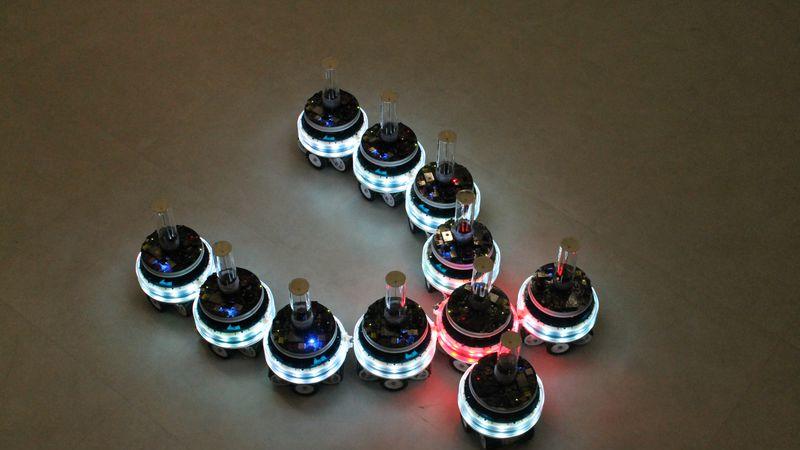RobotSwarm
Latest

Researchers create robots that can team up when they touch
To make robots cooperate with each other and work together, you have a couple of options. The first is to program them to work with information from their surroundings, with which individual robots can sort of organize and work towards a larger goal. However, that's not so easy to do. A second option is have one central command center that organizes all of the individual robots itself, but that leaves the system open to widespread failure if that central command goes down for some reason. But researchers have developed a method that bridges those two methods and their work was published today in Nature Communications.

Swarm robots attack your bookshelf, win AAAI Oscar
What's more frightening than a swarm of robots? An award-winning swarm of robots trained to raid your library -- that's what. This SciFi-worthy outfit of mechanized literature swindlers, known as the "Swarmanoid," landed themselves the Best Video Award at this week's AAAI (Association for the Advancement of Artificial Intelligence) conference in San Francisco. The video in question features the mixed bag of eye-bots, hand-bots and foot-bots in an Oceans 11-style bookcase heist. Of course, there are probably easier ways to reach the top shelf (e.g. a ladder), but none that get us thinking about the end times quite like this. The full video awaits you after the break.

Swiss lab builds lightweight, tree-perching glider robot, swarms to follow
Last we heard from Mirko Kovac of the Switzerland-based EPFL Laboratory of Intelligent Systems, he was setting a robot high-jump record with his grasshopper-inspired bot. Now he's back with what might be an even more impressive robot -- a 4.6 gram glider that can fly headfirst into any surface, perch itself, and then detach on command. The idea there being that the gliders could be outfitted with sensors and deployed en masse in difficult to reach areas -- Kovac gives the example of a swarm equipped with heat-sensors that could attach themselves to trees and monitor for forest fires. What's more, he says that the same perching mechanism could also be applied to other robots -- possibly even a hybrid of the glider and his grasshopper bot that could hop and fly around before finding a spot to perch itself. Head on past the break to see Kovac explain it himself on video.

Researchers create wirelessly-powered robot swarm
Wireless power has come a long way from Nikola Tesla's early ruminations on the matter, and it looks like some researchers from Duke and Georgia Tech are now taking the idea to its logical, robot-powering conclusion. While their setup (thankfully) isn't yet able to power robots beyond the confines of the Q L-C resonator-equipped table, it does appear to work remarkably well in that limited proof-of-concept, with five bots each equipped with a non-resonant pickup coil able to follow a path around the table, or simply sit still to recharge their batteries. They were even able to power an LED light with the system for good measure. Natually, they eventually hope to expand the system to power larger swarms of robots and do away with the need for batteries altogether. Yeah, that's a good idea. Head on past the break for a video.

Swarm robots invade UK conference, lets hope they're all accounted for
It looks like the Artificial Life XI conference hosted by the University of Southampton was home to a unsettling number of swarm robots this week, including some we've seen and some we haven't. Among the more interesting of the lot are the matchbox-size bots (pictured above) developed by a group of researchers from the host university, which apparently cost just £24 (or $46) each to produce and are able to independently divide up tasks with no central program controlling them. They're even able to redistribute tasks if some of the robots fail or are removed from the area, which the researchers say makes them ideal for use in far-flung locations and, as the BBC's video available at the link below shows, they're also adorable when set to music.[Thanks, David]

Swarm robotics project further ensures our doom
Much to our dismay, this isn't the first swarm project that really makes us wonder how long humans will be running things on Planet Earth. MIT's own James McLurkin was recently down in Austin, Texas showing off a dozen or so of his hundred (is that even legal?) robots. The group was reportedly able to spread out, clump together, play follow the leader and circle the wagons, all of which were just ploys to distract us from seeing precisely how much they really know. Each of the appropriately-titled SwarmBots featured eight AA batteries, a 1.1-watt speaker, behavior LEDs, a radio, camera and an IR communications system. For those curious, each one cost around $2,000 to build, but Mr. McLurkin suggested that these were a bargain compared to typical research bots. It's all about perspective, baby.[Via Futurismic]



